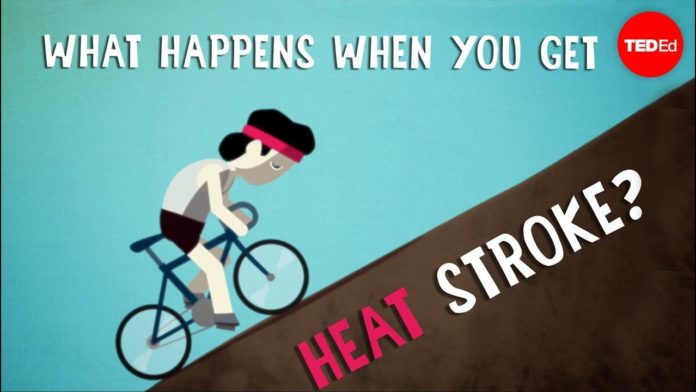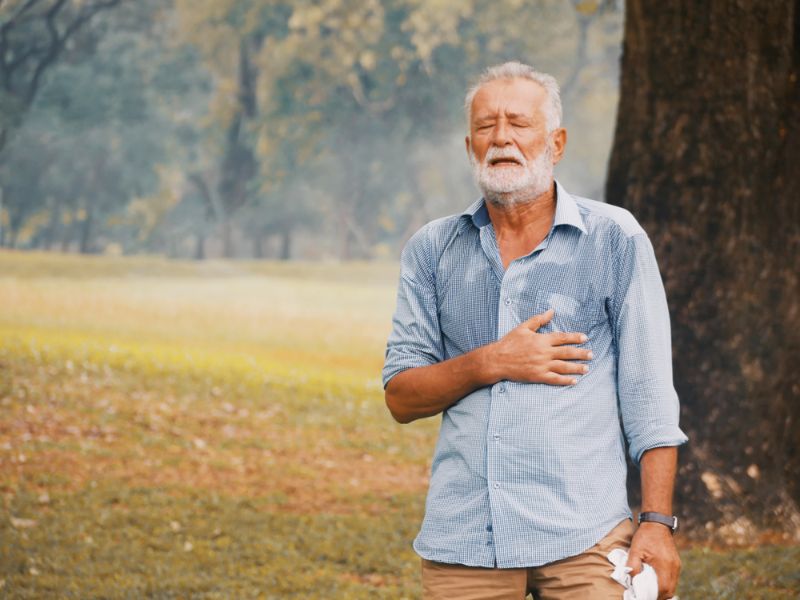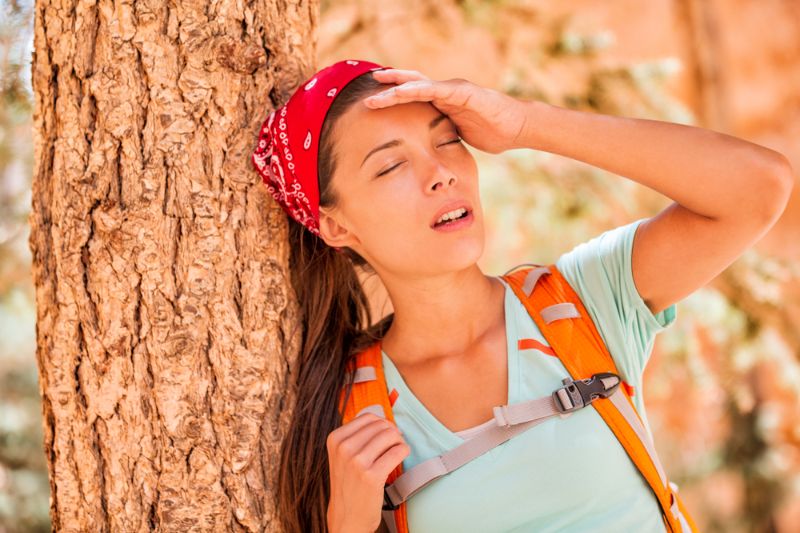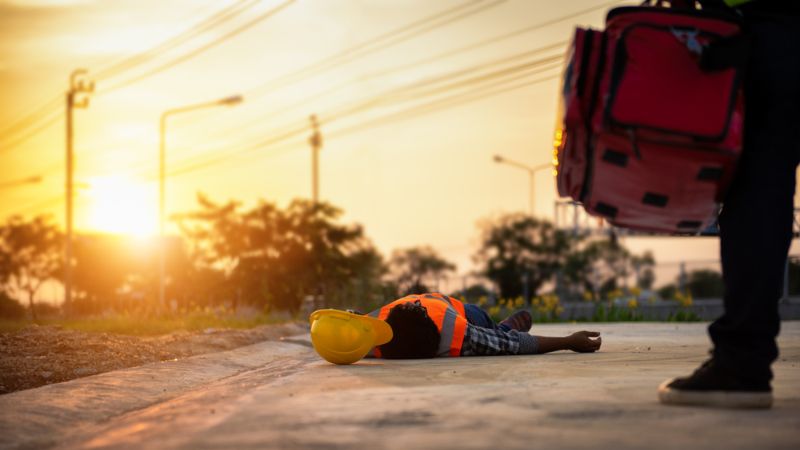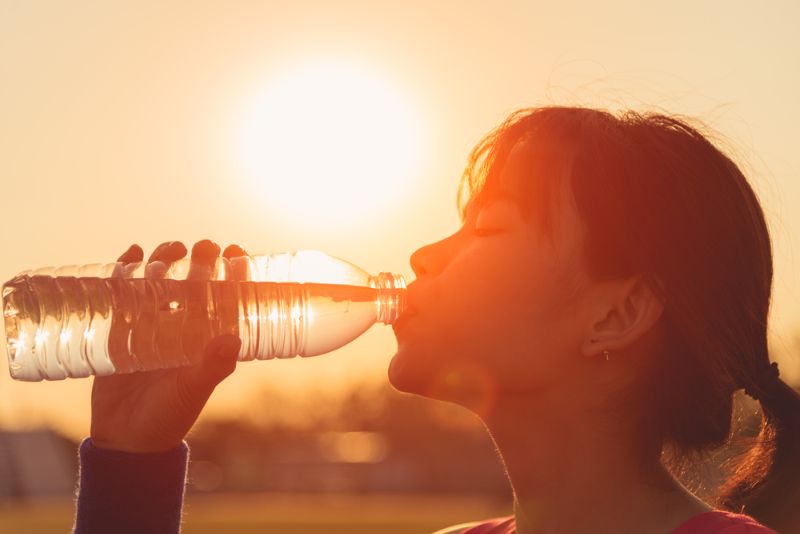You should always keep an eye out for heat stroke symptoms when you’re under extreme weather conditions. It is the last thing you can afford to have, especially if you’re in the middle of nowhere, whether you’re camping or in a bug-out situation.
It is a serious form of heat-related illness and needs to be dealt with as a medical emergency. Get help as soon as possible and call 911 (I can’t stress this enough!)
If you have first aid training, this is the time to put it to good use, whether you are the one experiencing the condition or somebody else.
Heat Stroke Symptoms, Signs, and Prevention
What is a Heat Stroke?
Also known as sunstroke, heat stroke can damage the brain and other vital organs, and if left untreated it can quickly become fatal. Most of the time, it is people who are more than 50 years old who are affected, but when the sun is hot…no one is safe.
This is especially compounded when you’re hiking, camping, or bugging out and carrying a heavy pack.
It’s important to remember that heat stroke can start as heat cramps, heat syncope or fainting, or heat exhaustion.
If you notice that you have the signs and symptoms of any of these three heat-related illnesses, try to manage them immediately. However, there are times when heat stroke can happen even without cramps, fainting, or exhaustion.
Heat stroke is your body’s internal thermostat gone haywire. It happens when your body has lost the ability to control its temperature. This incredibly dangerous illness is caused by being in a very hot place for a long time and at the same time being dehydrated.
According to medical experts, once your core body temperature is over 105°F you are in heat stroke and at serious risk.
Symptoms of Heat Stroke
As we just mentioned, the best way to find out you have heat stroke symptoms is the body temperature which is higher than 105°F. Usually, the first sign of this illness is fainting.
Here are the common heat stroke symptoms:
- Dry, red, and hot skin
- No sweating even when the body is very hot
- Weakening of the muscles or cramps
- Dizziness
- Vomiting/nausea
- Pulsating, intense headache
- Rapid heartbeat
- Unconsciousness
- Disorientation
- First Aid
What to Do When You Think a Person is Having a Heat Stroke
- Call 911 right away or bring the person to a hospital if you think that someone has heat stroke. Do not waste any time.
- Apply first aid while waiting for the medics.
- Take the person to a cool or shaded area, preferably an air-conditioned place.
- Remove clothing that is not needed.
- Use a thermometer to measure the person’s temperature, and use first aid measures to bring down the temperature to about 101°F. (If you cannot find any thermometer, just go ahead with the first aid.)
In the process, you can also resort to some of these cooling strategies:
- Give the person space to breathe. If it’s possible for you to fan air over, do this immediately while you keep him or her damp with a sponge.
- Reduce the temperature of the person. You can cool him or her down by applying an ice pack on areas such as armpits, groin, and neck. These are areas sensitive to temperature.
- If the ice packs won’t do, you can choose to let the person take a plunge in a tub of cold water or under a dripping cold water shower.
Any delay in response time can already be dangerous, and any wrong move can also increase the risk to the affected person. If you’re not sure what to do, call 911 or a hospital for instructions.
Risk Factors for Heat Stroke
Age is a consideration in heat stroke. Older people are more likely to be the victims, especially those who live in small apartments or in places where there is poor airflow.
People who are dehydrated, have an existing medical condition, or are alcoholics are also more prone.
Heat stroke happens when the heat index is quite high. The heat index is the discomfort you feel after feeling the combined effects of relative humidity and air temperature.
When the relative humidity reaches 60% and above, you should be alarmed, as it will become more difficult for your body to bring down its temperature to normal because of increased sweat evaporation. Much more so if the heat index significantly reaches 90°F or higher.
Your best move is to pay attention to weather reports. Take note that your chosen activities can either increase or decrease the heat index. Being exposed to full sunshine shoots up the heat index by an alarming 15 degrees.
Your residential area is also a risk factor. Living in urban areas increases the likelihood of heat stroke. These are places where atmospheric conditions are stagnant, and of course, the airflow is poor.
The “heat island effect” explains how asphalt and concrete can absorb and store heat during the daytime and how they release the heat at nighttime. You may be better off surrounded by trees and natural grounds then.
Unexpected Risk Factors For Heat Exhaustion:
- Age. Inability to adjust to heat comes with age. Infants and children until 4 years old are potential patients, so do senior people whose age is above 65.
- Health conditions. Weight problems, heart, lung, skin, or kidney ailments, hypertension, diabetes, mental illness, sickle cell trait, alcoholism, and conditions that cause fever are among the health risk factors.
- Medications. You are vulnerable if you take any of these: illegal drugs (e.g. cocaine, methamphetamine), antihistamines, diet pills, diuretics, sleep medications (e.g. sedatives, tranquilizers); stimulants, seizure medications, heart and blood pressure medications (e.gbeta-blockers, vasoconstrictors) and psychiatric illnesses medications (e.g. antidepressants and antipsychotics).
People with diabetes are prone to hospitalization and death because of heat-related illnesses. Even worse is that many people seem to underestimate this health risk especially during heatwaves. Thus, you should also check with your doctor.
Take extra measures in knowing your state of health and your medical needs, which will affect the way you cope with heat and humidity.
Preventing/Addressing Heat Stroke Symptoms
Your choice of location during extreme heat index can save your life. Bugging out may not always be a good idea when it’s the middle of summer or there’s a heatwave.
If possible, secure yourself in an air-conditioned environment or one with a good amount of airflow to keep temperatures as low as possible. If you have no other choice and must be outdoors, safeguard your health by doing the following:
- Avoid wearing dark-colored and tight-fitting clothes.
- Wear a thick hat, possibly wide-brimmed.
- Apply sunscreen, preferably with a sun protection factor (SPF) of 30 or above.
- Bring a bottle of water with you. Drink lots of fluids, 8 glasses or more, to prevent dehydration. You can also drink fruit or vegetable juice.
- Have a ready supply of electrolyte-rich sports drinks, if you feel very thirsty. Sports drinks replace the salt and other nutrients you lost because of extreme heat.
When it comes to outdoor exercise, remember, moderation is key. DON’T OVERDO IT!
You can lessen the likelihood of heat stroke by staying hydrated. Two hours before the exercise, drink 3 cups of water or a sports drink (24 ounces.)
Drink another cup (8 ounces) directly before the start of exercises and another cup (8 ounces) every 20 minutes during exercises. Even if you don’t “feel” thirsty, drink up.
Reschedule outdoor activities. Do them at a later time or date where the temperature is cooler, possibly at night time.
If you’re still a little worried, here are other strategies you can do to prevent it and check for heat stroke symptoms:
- Check your urine. If it’s darker in color, you are likely to be dehydrated. The only remedy is to drink lots of liquid.
- Pay attention to your weight before and after an activity. Any lost water weight can be replenished by, again, drinking lots of fluid.
- Choose your drink wisely. Avoid caffeine or alcohol which are diuretic substances. They make you lose more body fluid.
- Avoid salt tablets unless recommended by your doctor. You can however choose sports beverages or fruit juice to replenish lost salt and electrolytes.
Remember that increasing liquid intake also has limitations. If you have conditions like epilepsy, heart, kidney, or liver diseases, eating problems that restrict fluid intake, or fluid retention problems, you should seek your doctor’s advice first.
Improve your ventilation or air-flow system at home. You can buy fans or an air-conditioning unit to keep you cool under hot weather.
You can spend 2 hours at the very least in a cold room just to bring your temperature down.
Besides that, you can also do the trick of drawing the curtains or blinds when it’s very hot. This prevents the coming in of heat and cools down a little the room temperature.
At night, open the windows to increase airflow.
Watch this video from Ted-Ed as they discuss heat stroke symptoms and what happens to your body:
Now that you know some heat stroke symptoms how they can lead to serious injuries and even death, you can start to take precautions at all times.
Be informed, and be prepared. You must watch the heat index closely, pay attention to weather updates, and plan your activities accordingly, avoiding strenuous labor during extremely hot temperatures.
Don’t forget, increasing hydration and airflow are both critical to heat stroke prevention. Also, listen to your doctor.
Remember, pay attention to your body, and if you begin to notice any of the above symptoms if at all possible seek out a doctor immediately.
Heat stroke symptoms don’t just happen, it’s a compounding set of heat-related illnesses, and it starts with heat exhaustion.


